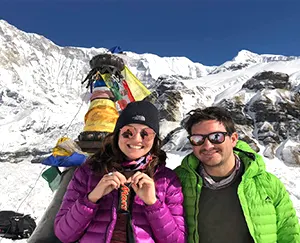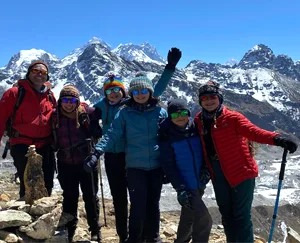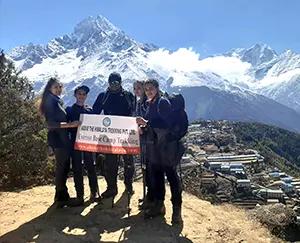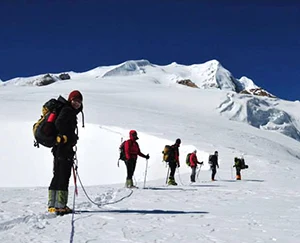Merak Sakteng Trek
Trip Highlights of Merak Sakteng Trek
The following are some major highlights of Merak Sakteng Trek:
- Brokpa Culture: The Merak Sakteng trek allows you to experience the lifestyle of semi-nomadic Brokpa people. These people have been living in the highlands for several centuries now. They are known for their unique traditional attire, intricate weaving, and yak herding practices.
- High Mountain Passes: An interesting element of the Merak Saktheng Trek is that you will go through Unchanged Pass. It is high at an elevation of 4,153 meters. This climb may be challenging, but it can be rewarding for photography enthusiasts and nature lovers.
- Sakteng Wildlife Sanctuary: The Sakteng Wildlife Sanctuary is a major attraction of the Merak Sakteng Trek. This sanctuary is a remote protected area that aims to preserve the location’s ecological elements. Moreover, the Sakteng Wildlife Sanctuary is home to species like red pandas, snow leopards, Himalayan black bears, and several bird species.
- Rhododendron Forests: You will come across dense Rhododendron forests during the Merak Sakteng Trek. The beauty of the Rhododendron flowers depends on the season you’re trekking. Trekkers can find the most beautiful scenery of these flowers during the spring season. Early fall is just as good to pass the beauty of these rich, red flower trees.
- Alpine Meadows and Pastures: The simple valley life of the people along the alpine meadows and pastures can be a fascinating sight. People who have been living in the city can relate more to such an experience. From yak pastures to sights of people raising livestock and the alpine visuals along the trek, you will be offered nothing but an aesthetic sight.
- Remote Himalayan Villages: The remote Himalayan villages of Merak and Sakteng are best known for their friendly locals. Even though they are far from the modern world, they are always keen to learn about those visiting them from the outside world. You will get to share stories and have them tell you about their own lives and cultures, while you get to relish traditional food items and diverse traditions.
- Photography Opportunities: The rhododendron forests are rather dense and serve beautifully as a photography backdrop. The Brokpa people will give you many photographic moments as well.
- Cultural Monuments: Rangjung Monastery, which was founded by His Eminence Garab Rinpoche, is a major cultural monument you’ll visit during the Merak Sakteng Trek. Furthermore, there are plenty of smaller chortens you will find on your trails.
- Scenic Rivers and Suspension Bridges: Eastern Bhutan offers you the views of scenic rivers that are perfect looking amid the picturesque meadows. Also, you will be passing suspension bridges that add to the adventure.
- Off Beaten Path: If you are an adrenaline junkie, you will likely love trekking through the off-beaten pathways of the Merak and Sakteng Trek. This trek will not bore you at any moment.
Trip Extension
Suppose you have more time in Nepal after this trip. In that case, we can help you to extend your trip by running different treks in Nepal, tours in Bhutan and Tibet, Jungle safari tours at Chitwan, Bardia, and other National parks, Nepal luxury hotel booking, Rafting, Ultra-light flights, or any other travel-related services. You can get more information here.
Most Asked Questions by Travellers
![]() General
General
The Merak Sakteng Trek is a journey of 7 days that takes you through rhododendron forests, Bhutanese villages, and alpine meadows in remote Eastern Bhutan.
The Merak Sakteng Trek is 7 days long. Likewise, this trek can be considered moderately difficult and is suitable for adventure-loving trekkers with good physical fitness.
A trekker who is physically and mentally fit and have adequate experience of hiking for several hours can attempt this trek.
While children below the age of 15 are not suggested to trek to Merak Sakteng. Older teenagers who are physically and mentally fit can trek.
While mobile network is available in major villages, don’t expect to enjoy such facilities in high passes or remote areas.
Yes, you can combine this trek with other Bhutan treks in Eastern Bhutan or cultural journeys in Trashigang and valleys closeby.
![]() Preparation & Fitness
Preparation & Fitness
A trekker can physically prepare for the Merak Sakteng trek by engaging in cardio, strength training, and short hikes.
While prior high-altitude experience is not compulsory, this can be an added benefit for the trekker.
You can acclimate by taking your halt at Sakteng rather seriously. Other than that, gradually ascending and drinking water sufficiently can be helpful.
![]() Permits
Permits
Yes, you will need permits before entering locations like Merak, Sakteng, and the Sakteng Wildlife Sanctuary during the Merak Sakteng Trek.
You can obtain the permits through a licensed trekking operator.
Yes, the trekkers must stay aware about wildlife safety, park rules, and by staying within designated trails.
![]() Insurance and Visa
Insurance and Visa
Yes, travel insurance is necessary for the Merak Sakteng trek to cover emergencies and even helicopter evacuation.
Yes, visitors need a visa for Bhutan and get one with the help of a licensed tour operator.
Yes, your insurance will cover emergency evacuation even when you’re in the most remote areas.
![]() Guides & Support Staff
Guides & Support Staff
Yes, hiring a guide is mandatory. You will not only be following the regulations as a trekker but also be ensuring your own safety.
Yes, porters are available to carry your tents, trekking bags, and other essentials during the 7 days rugged trails trek.
Your guides will be fluent in both English and Bhutanese making it possible for them to talk to both trekkers and locals.
![]() Accommodation and Facilities
Accommodation and Facilities
Trekkers will stay at scenic campsites during the trek. There are options for stays at local teahouses at Merak and Sakteng as well.
You can access basic bathroom facilities during the trek. It is suggested that you carry cleaning essentials of your own.
You need to carry a power bank as there is limited electricity in the trek. Charging ports won’t be available everywhere.
![]() Food and Drinks
Food and Drinks
You can enjoy different types of Bhutanese food like ema datshi, red rice, momos, etc. during the trek. Likewise, you can also enjoy food options like pizza, pasta, etc.
Drinking water is not safe everywhere in the Merak Sakteng trails. Hence, it is suggested that you carry a water bottle and water purification tablets everywhere.
Yes, vegetarian food options are available everywhere. You may not find proper vegan food in the remote areas.
![]() Weather & Seasons
Weather & Seasons
The best time to trek would be during spring and autumn seasons. These are the seasons when sky is clear, the air is fresh, and the views of the surrounding are better.
No, it is not safe to trek during the monsoon season. You may need to follow extra precautions and might even face flight and trek delays.
The daytime temperatures during the Merak Sakteng Trek ranges between 10 to 20 degree Celcius whereas at night time, the temperature may drop below 0 degree Celcius.
![]() Health & Safety
Health & Safety
The symptoms of altitude sickness include headache, nausea, dizziness, or fatigue. Gradual ascent and acclimatization can be of help.
Yes, you will find basic medical assistance through your trekking crew assigned by your tour operator. For emergencies, a trekker will be evacuated to Trashigang or larger hospitals.
You can handle wildlife encounters by keeping a safe distance from animals and by avoiding feeding them.
![]() Packing & Gear
Packing & Gear
Basic clothing essentials include thermal base layers, fleece coats, waterproof jackets, and warm caps.
Yes, trekking poles are highly recommended as there are going to be several ascents and descents.
Other gear to carry during the Merak Sakteng trek include hiking boots, gaiters, gloves, a headlamp, a sleeping bag, a water bottle, and sunscreen.
![]() Booking & Payment
Booking & Payment
Trekking in Bhutan requires you to book the trek through a licensed tour operator who will handle logistics, permits, etc.
Cost of the Merak Sakteng trek depends on the group size, services, and accommodation a trekker enjoys during their journey.
Yes, tour operators require a deposit to confirm the trek and to manage your logistics, guides, permits, etc.
![]() Transportation & Flight
Transportation & Flight
You can reach Trashigang through road transport or through domestic flights from Paro.
Yes, you need vehicles from Trashigang to Chaling at the beginning and Phongmay to Trashigang in the end.
Yes, roads in Eastern Bhutan are safe and well maintained. The trekking trails are not as maintained which adds up to the adrenaline rush among trekkers.
Best Price Guaranteed, Easy to change Date, Instant Confirmation
Book This TripBook with Confidence
- Flexible bookings and easy trip date changes
- Personalized service and customized group sizes
- Safe travels with owner-operated services and highly experienced guides
- Best price guarantee for the most value for your money
- Secure & easy online booking
Your Trek Leader
 Enjoy Himalayan scenery with the help of Nepal’s best guides with Government license holders and got training in first-aid, our Trip Leaders, know where you’ll find the best photos, most fascinating wildlife, and the best stream crossings.
Enjoy Himalayan scenery with the help of Nepal’s best guides with Government license holders and got training in first-aid, our Trip Leaders, know where you’ll find the best photos, most fascinating wildlife, and the best stream crossings.

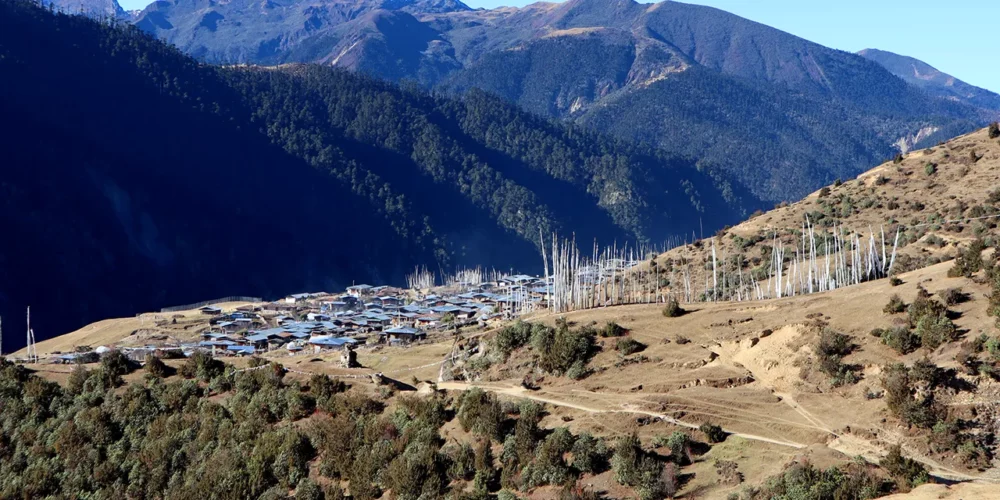




 Have Questions?
Have Questions?